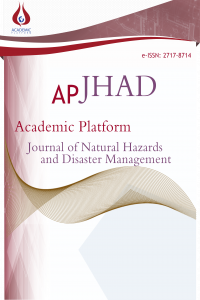The Situation of Combined Disasters Caused by Climate Change: Antalya
Anahtar Kelimeler:
Antalya, Combined Disaster, Climate Change
The Situation of Combined Disasters Caused by Climate Change: Antalya
There are often negative and difficult-to-manage natural disasters that leave permanent effects and traces in the natural and built environment. While the proportion of people living in cities is expected to increase to 66% in 2050, considering that disasters caused by climate change will increase rapidly, the probability of simultaneous/simultaneous occurrence of multiple hazards is high. It is an inevitable fact that combined disasters (earthquake, pandemic, flood, storm, etc.) will occur more and disasters will occur especially in coastal cities. The aim of this study is to determine the combined (simultaneous/simultaneous level) situations of disasters caused by climate change in Antalya in 2012-2021 with content analysis method and to draw attention to the importance of combined / multiple hazard risk management before disasters occur.
Keywords:
Antalya, Combined Disaster, Climate Change,
___
- [1] P. Wallemacq. Economic losses, poverty & disasters: 1998-2017, centre for research on the epidemiology of disasters (CRED). Belgium: CRED, 2018.
- [2] M.C. Quigley, J. Attanayake, A. King and F. Prideaux. “A multi-hazards earth science perspective on the COVID-19 pandemic: the potential for concurrent and cascading crises”. Environ. Syst. Decis., 40 (2), 199-215, 2020.
- [3] M.M. Rahman, M. Bodrud-Doza, M. Shammi, A.R. Md. Towfiqul Islam and A.S. Moniruzzaman Khan. “COVID-19 pandemic, dengue epidemic, and climate change vulnerability in Bangladesh: scenario assessment for strategic management and policy implications”. Environ. Res., 192, 110303, 2021.
- [4] J.C. Gill and B.D. Malamud. “Anthropogenic processes, natural hazards, and interactions in a multi-hazard framework”. Earth Sci. Rev., 166, 246-269, 2017.
- [5] S. De Angeli, B.D. Malamud, L. Rossi, F.E. Taylor, E. Trasforini and R. Rudari. “A multi-hazard framework for spatial-temporal impact analysis”. International Journal of Disaster Risk Reduction, 73, 102829, 2022.
- [6] S. Kahraman, E. Polat and B. Korkmazyürek. “Afet yönetim döngüsündeki anahtar terimler”. Avrasya Terim Dergisi, 9(3), 7-14, 2021.
- [7] P. Shi, L. Lu, J. Wang and W. Chen. “Disaster system: disaster cluster, disaster chain and disaster compound”. Journal of Natural Disasters, 23(6), 1-2, 2014.
- [8] P. Shi. “Theory and practice of disaster research”. Journal of Nanjing University, 11, 37-42, 1991.
- [9] D. Alexander. “A magnitude scale for cascading disasters”. Int J Disaster Ris, 30, 180-185, 2018.
- [10] J. Zscheischler, S. Westra, BJJM. Van Den Hurk et al. “Future climate risk from compound events”. Nat Clim Chang, 8, 469-477, 2018.
- [11] G. Pescaroli and D. Alexander. “Understanding compound, interconnected, interacting, and cascading risks: a holistic framework”. Risk Anal, 38, 2245-2257, 2018.
- [12] E. Ferris, D. Petz and C. Stark. “The year of recurring disasters: a review of natural disasters in 2012”. The Brookings Institution—London School of Economics Project on Internal Displacement (March, 2013), 2013.
- [13] MC. de Ruiter, A. Couasnon, MJC. van den Homberg, JE. Daniell, JC. Gill and PJ. Ward. “Why we can no longer ignore consecutive disasters”. Earths Future, 8, 1-19, 2020.
- [14] J. Zscheischler, S. Westra, B. J. J. M. van den Hurk, S. I. Seneviratne, P. J. Ward, A. Pitman, A. AghaKouchak, D.N. Bresch, M. Leonard, T. Wahl, X. Zhang. “Future climate risk from compound events”. Nature Climate Change, 8(6), 469–477, 2018.
- [15] IPCC (Intergovernmental Panel on Climate Change). Managing the risks of extreme events and disasters to advance climate change adaptation. Geneva: IPCC, 2012.
- [16] C. Svensson, and D.A. Jones. “Dependence between extreme sea surge, river flow and precipitation in eastern Britain”. International Journal of Climatology, 22(10), 1149-1168, 2002.
- [17] H.W. Van den Brink, G.P. Konnen, J.D. Opsteegh, G.J. Van Oldenborgh, and G. Burgers. “Estimating return periods of extreme events from ECMWF seasonal forecast ensembles”. International Journal of Climatology, 25(10), 1345-1354, 205.
- [18] Online Etymology Dictionary. “Combine”. Internet: www.etymonline.com/search?q=combine, August 25, 2022 [2022].
- [19] CRED. “Disaster classification”. Internet: https://public.emdat.be/data.9, Feb. 10, 2022 [2022].
- [20] M. Dilley, R.S Chen, U. Deichmann, A.L. Lerner-Lam, M. Arnold, J. Agwe, P. Buys, O. Kjekstad, B. Lyon and G. Yetman. Natural disaster hotspots: a global risk analysis, disaster risk management, Series No. 5-34423. Washington DC: The World Bank, 2005.
- [21] S. Kahraman and E. Polat. “Meteorolojik kaynaklı afetlere karşı bir meydan okuma: dirençli planlama”. Resilience, 3, 307-318, 2019.
- [22] L. Bull-Kamanga, K. Diagne, A. Lavell, E. Leon, F. Lerise, H. MacGregor, A. Maskrey, M. Meshack, M. Pelling, H. Reid, D. Satterthwaite, J. Songsore, K. Westgateve and A. Yitambe. “From everyday hazards to disasters: the accumulation of risk in urban areas”. Environment and Urbanization, 15(1), 193-204, 2003.
- [23] S.V. Lall and U. “Deichmann. Density and disasters: economics of urban hazard risk”. World Bank Research Observer, 27(1), 74-105, 2012.
- [24] MGM (Meteoroloji Genel Müdürlüğü). Türkiye Meteorolojik Afetler Değerlendirmesi (2010-2021). Ankara: Meteorolojik Afetler Şube Müdürlüğü, 2022.
- [25] SV. Lall and U. Deichmann. “Density and disasters: economics of urban hazard risk”. World Bank Research Observer, 27(1), 74-105, 2012.
- [26] K. Krippendorff. Content Analysis an Introduction to Its Methodology. Sage Publications: USA, 2004.
- [27] U. Kuckartz and S. Radiker. Analyzing qualitative data with MAXQDA. Springer International Publishing: New York, 2019.
- Yayın Aralığı: Yılda 2 Sayı
- Başlangıç: 2020
- Yayıncı: Akademik Perspektif Derneği
Sayıdaki Diğer Makaleler
Md. Abdul Al MOHİT, Md. TOWHİDUZZAMAN, Mossa Samima NASRİN, Shourov Kumar GHOSH
Forest Fire Analysis with Sentinel-2 Satellite Imagery: The Case of Mati (Greece) in 2018
Deniz BİTEK, R. Cüneyt ERENOĞLU
Designing an Online Typhoon Mitigation Program
Resti Tito VİLLARİNO, Maureen Lorence VİLLARİNO
The Situation of Combined Disasters Caused by Climate Change: Antalya
